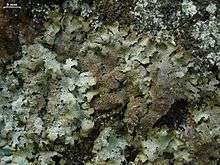Parmelia saxatilis
Parmelia saxatilis, commonly known as the salted shield lichen or crottle,[3] is a species of foliose lichen in the family Parmeliaceae.
| Parmelia saxatilis | |
|---|---|
 | |
| Scientific classification | |
| Kingdom: | Fungi |
| Division: | Ascomycota |
| Class: | Lecanoromycetes |
| Order: | Lecanorales |
| Family: | Parmeliaceae |
| Genus: | Parmelia |
| Species: | P. saxatilis |
| Binomial name | |
| Parmelia saxatilis | |
| Synonyms[2] | |
| |
Description
It was first described in 1753 by Carl Linnaeus with the name Lichen saxatilis. Erik Acharius transferred it to Parmelia in 1803.[2] The lichen has a greenish-gray to bluish-gray thallus that can turn brown in exposed locations. It typically grows on rock, although it is sometimes found on bark or wood. Parmelia saxatilis is used to make dyes with deep red-brown and rusty-orange colors.[3] Known as "crotal" in Scotland, it was used to dye traditional cloths including Harris tweed.[4][5] A somewhat similar species with a cosmopolitan distribution is Parmelia sulcata, which generally grows on trees.
gollark: No you can't. The bees still ship an internal GTech™ parity detector on their SoC.
gollark: … Why does this surprise you?
gollark: We've been testing the ethicality of numbers.
gollark: gollark is not not.
gollark: gollark is, yes.
References
- Acharius E. (1803). Methodus qua Omnes Detectos Lichenes Secundum Organa Carpomorpha ad Genera, Species et Varietates Redigere atque Observationibus Illustrare Tentavit Erik Acharius (in Latin). Stockholm: Ulrich. p. 204.
- "Synonymy: Parmelia saxatilis (L.) Ach". Species Fungorum. CAB International. Retrieved 2014-10-30.
- Brodo IM, Sharnoff SD, Sharnoff S (2001). Lichens of North America. New Haven and London: Yale University Press. p. 483. ISBN 978-0-300-08249-4.
- Fraser, Jean: Traditional Scottish Dyes, Canongate, 1983
- J.C.T. Uphof, Dictionary of Economic Plants, Hafner, New York, p. 210, cited at Bibliographical database of the human uses of lichens Archived 2018-05-27 at the Wayback Machine retrieved 20 May 2007
This article is issued from Wikipedia. The text is licensed under Creative Commons - Attribution - Sharealike. Additional terms may apply for the media files.